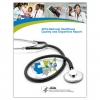Summary from AHRQ’s 2014 National Disparities Report
The National Healthcare Quality and Disparities Reports from the Agency for Healthcare Research and Quality (AHRQ) are annual reports to Congress that provide a comprehensive overview of the quality of healthcare received by the general U.S. population and disparities in care experienced by different racial, ethnic and socioeconomic groups.
The purpose of the reports is to assess the performance of our health system and to identify areas of strengths and weaknesses in the healthcare system.
Following is a summary of findings from AHRQ’s 2014 National Healthcare Quality & Disparities Report on the National Quality Strategies’ (NQS) six priorities—Patient Safety, Person-Centered Care, Care Coordination, Effective Treatment, Healthy Living and Care Affordability.
- Half of Patient Safety measures that improved were led by a 17 percent reduction in rates of hospital-acquired conditions.
- Person-Centered Care improved steadily.
- Care Coordination improved as providers enhanced discharge processes and adopted health information technologies.
- Effective Treatment in hospitals achieved high levels of performance resulting from measures publicly reported by the Centers for Medicare & Medicaid Services (CMS) on Hospital Compare.
- Healthy Living improved in nearly half of the measures followed as a result of selected adolescent vaccines from 2008 to 2012.
- Care Affordability worsened from 2002 to 2010 and then leveled off.
atom Alliance is dedicated to working with healthcare providers to improve quality of care and reduce disparities. The Alliance is especially focused on reducing disparities in the areas of cardiac health, diabetes care and adult immunizations. Learn more at www.atomalliance.org.



